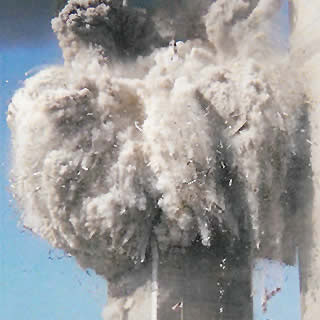Officially, they've admitted the collapses were not caused by the plane crashes. Columns were damaged, of course, but the damage didn't extend down the length of the columns. And remember that Building 7 wasn't even hit by a plane. So, its columns weren't damaged at all. It has also been admitted that it wasn't burning jet fuel that did it because that burned off quickly and mostly in the air. Again: Building 7. Officially, the NIST Report has it that "office fires" felled the towers. In other words: burning furniture and computers and stuff like that.
There is no basis to claim a gravitational collapse. The buildings were made of steel, and the joints between the girders were just as strong as the girders themselves. There were 93 stories below the point of impact in Tower 1, and you have to think of that as a monolith. There were 110 stories in total, and those 93 stories below were supporting the 17 stories above, and they were doing that constantly since 1973. So, you can't say the weight of the falling structures did it because the building was designed to support that weight.
The fire involved was very limited. The lower part of the building wasn't on fire at all, so it wasn't being weakened or compromised by fire. The combustion of a burning desk on the 95th floor could not be transferred to a desk or a girder or anything on the 75th floor. There was no weakness down there from what was going on above. It is insane to say that fire had anything to do with the buildings falling. It wasn't an inferno. It wasn't engulfed in flames. And, there was hardly any fire left by the time the collapse began. The idea that burning furniture caused steel girders to soften and weaken and melt is crazy. Again: Building 7.
So, forget about fire. You can't blame this on burning furniture. And as I said, the weight of the small portion above falling on the grand behemoth below couldn't do it either. But what about the momentum of the falling piece? When it gave way, didn't it gain energy from falling? Yes, but not to the extent of being able to crush the 93 floor behemoth below. That's ridiculous. Besides, the part that was falling was in such bad condition that it was disintegrating. There is no way its mass could be directed straight down causing a symmetrical collapse. Once the falling pieces reached solid building- and it was mostly solid building- the falling pieces would have bounced over the edge of it. It would have fallen off the solid building; it would have went over the side; it would certainly not have gone through it. The buildings were imploded. It was a controlled demolition.
The following is from the website of the Architects and Engineers for 9/11 Truth. You should get to know them: www.as911truth.org
WTC Building #7, a 47-story high-rise not hit by an airplane, exhibited all the characteristics of classic controlled demolition with explosives:
- Rapid onset of collapse
- Sounds of explosions
- Symmetrical structural failure
- Free-fall acceleration through the path of what was greatest resistance
- Imploded, collapsing completely, landing almost in its own footprint
- Massive volume of expanding pyroclastic-like clouds
- Expert corroboration from the top European controlled demolition professional
- Foreknowledge of "collapse" by media, NYPD, FDNY
- FEMA finds rapid oxidation and intergranular melting on structural steel samples
- Several tons of molten metal reported by numerous highly qualified witnesses
- Chemical signature of the incendiary thermite found in solidified molten metal, and dust samples
- Slow onset with large visible deformations
- Asymmetrical collapse which follows the path of least resistance (laws of conservation of momentum would cause a falling, to the side most damaged by the fires)
- Evidence of fire temperatures capable of softening steel
- High-rise buildings with much larger, hotter, and longer lasting fires have never collapsed

- Destruction proceeds through the path of greatest resistance at nearly free-fall acceleration
- Improbable symmetry of debris distribution
- Extremely rapid onset of destruction
- Over 100 first responders reported explosions and flashes
- Multi-ton steel sections ejected laterally
- Mid-air pulverization of 90,000 tons of concrete & metal decking
- Massive volume of expanding pyroclastic-like clouds
- 1200-foot-diameter debris field: no "pancaked" floors found
- Isolated explosive ejections 20–40 stories below demolition front
- Total building destruction: dismemberment of steel frame
- Several tons of molten metal found under all 3 high-rises
- Evidence of thermite incendiaries found by FEMA in steel samples
- Evidence of explosives found in dust samples
- Slow onset with large visible deformations
- Asymmetrical collapse which follows the path of least resistance (laws of conservation of momentum would cause a falling, intact, from the point of plane impact, to the side most damaged by the fires)
- Evidence of fire temperatures capable of softening steel
- High-rise buildings with much larger, hotter, and longer-lasting fires have never collapsed


No comments:
Post a Comment
Note: Only a member of this blog may post a comment.